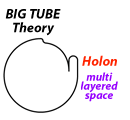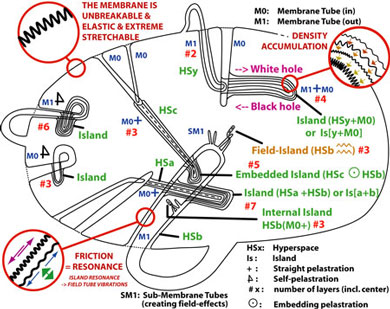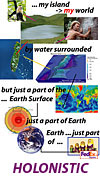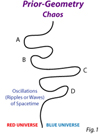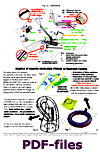|
|
|
De PRINCIPES van Pelastratie
Hieronder zie je een soort organische baarmoeder van ons Universum. Vanuit de universele baarmoeder - die ongeslachtelijk is - worden vanuit delen van haar eigen membraan plaatselijk ogenschijnlijk onafhankelijke kinderen (holons) gevormd door een actief en passief deel.
Deze tekening toont een aantal mogelijke combinaties. Belangrijk is te begrijpen dat in een holon meerdere spacetime lagen met elkaar zijn verbonden en dan ook constant met elkaar communiceren, dwz. onderlinge wrijving hebben. Deze locale kinetische energie brengt alle interacties van de natuurkunde.
Verder vertaling van volgende tekst volgt.
Each island (holon) contains the complete historical layering from the previous hyperspaces from which is founded. This way we can say that the system always keeps it's INTEGRITY. Since the internal and external 'skins' move as two or more couples oscillating systems they create between them FRICTION. That friction creates an overhaul oscillation which amplitude will depend from the internal (topological) structuring of the layers depending from their degree of membrane stress. This explains RESONANCE.
Next to that the membrane can create 'locally' also new tiny tubes which will act as membrane tentacles vibrating after the overhaul frequency of that specific island. We can call these outer-island tubes: Field tubes (because they represent the electro-magnetic and radiation fields).
Because the layers press upon each other they create 'tension', thus DENSITY. This way the various combinations between energy and matter are explained. The shift between energy and matter happens thus as follows: couple (white hole/pellon of A+B)-> de-couple (Black hole separation A and B) -> re-couple (New white hole/pellon A+X) and/or (new white hole/pellon B+Y).
The Big Tube sub-divides itself by pelastration in trillions of other tube-zones and inter- and intra-dimensional tubes. This process of creation can happen simultaneous on the MACRO- and MICRO-cosmic LEVEL.
Pelastration is an essential dynamic process to explain the creation of dimensions, matter and energy, motion, etc. and several joining activities, but is not the only process. Sub-tubes (such as the field-tubes) - resulting from the pelastration of several types of tubes - can also coil, knot, etc. with other tubes and provoking changes of conditions. For example by coiling they can create temporary conditions (joined resonance by joined connection) to attract (in fact capture) symbiotic other tubes (compare it with human reproduction). Another type of resonance is however also created by internal friction or over-heating of one or more layers in a tube-zone or the entry of new tubes (e.ge. adding new strings to the piano). The embedding of another 'micro-island' will influence the overhaul frequency.
The approach of Pelastration and Tunity shows that the each island keeps it's original layers (basic components) and historic design, which are although adapted during it's existence (island life-time frame) by internal changes (conform intra conditions, thus in accordance with internal 'allowed' growth and decay condintions) and by exogenous factors: which POSITION (i.e. transversing tubes may fix POSITION in a large network of islands) and CHANGE characteristics (embedding values).
Every island act thus like an isolated unit (with an own state of the system) but is in fact still in each of it's layers connected with it's founding states of structure. And the membrane is still the same.
Each island is thus a holon (Cfr. Arthur Koestler: A holon may be defined as 'one part within a larger whole that is itself also a whole containing smaller parts' -- a self-organizing phenomenon observed in all areas of life.) or a BIBIB (a Box-in-Box-in-Box).
|
|
|
Difference with the traditional String theory:
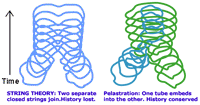
|
|
|
|
|
